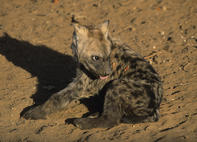The spotted hyena (Crocuta crocuta) is the largest of the hyena family. They look like very large, heavily built dogs, usually with a length of 120 cm to 180 cm and weight of 60 kg to 80 kg. Spotted hyenas have short off-white to fawn-yellow, dirty grey coats with numerous irregular dark brown spots or blotches that tend to fade with age.

A short mane of hair stands upright on its back. Spotted hyena ears are rounded and not pointed like the ears of the brown hyena, and their front legs are longer than their back legs, resulting in their shoulders being higher than their rumps. They are also referred to as laughing hyenas, because of their giggling and cackling calls usually made when agitated or attacking animals.
Female spotted hyena have up to three times more testosterone than males, so are up to 10% larger than the males, significantly more aggressive and the dominant ones in the clans. They have a highly sophisticated clan hierarchy, with a female offspring taking over when the alpha female dies. Apparently, there are exceptional cases where the male will lead a clan.
Lower-ranking females may split from the group to form their own clans. To prevent inbreeding, most sons immigrate to other clans. Social relationship with other males is more important than the size of a male, so they need to form new allegiances when they move to another clan. It is difficult to tell males and females apart, since females have a fatty pseudo-scrotum and an erectile clitoris, which looks like the penis of the males.
The strange form of the female’s clitoris complicates mating, since this part becomes prickly when erect. Males therefore have to be calm and precise during the mating process, which also may be why passive males usually have greater success in courting females. Spotted hyenas become sexually mature from about three years old, with breeding taking place throughout the year.
One to four pups are usually born after a gestation period of about 110 days. The cubs are born through the pseudo-penis, resulting in up to 60% of cubs suffocating on their way out.
The small size of the birthing canal is often fatal to especially first-time mothers. Females look for a birth den just before giving birth and the cubs are carried to a communal den about two weeks after they were born.
The cubs are born with open eyes and suckle on the mother until they are 12 to 18 months old. They start snacking on meat killed near the den from five months of age. They are usually left at the den with a babysitter while the mother is hunting.
Killing and Feeding Pattern

People used to think that spotted hyenas were cowardly scavengers, but in some Eastern African countries they are believed to be owned and ridden by witches because of their cunning hunting tactics and nocturnal nature. Research by Gus Mills revealed that spotted hyenas hunted more than scavenged in some areas, with packs chasing prey for kilometers before the prey collapses in exhaustion.
Other studies confirmed that lions, in some areas, might even scavenge more from hyenas than the other way around. They may hunt individually or in packs. The diet of the spotted hyena ranges from insects to large game animals.
You don’t want to mess with spotted hyenas. They have the strongest jaws in proportion to their body size of any other mammal, which allows them to crush the bones of even giraffes. Livestock may be targeted, but this is rare, since spotted hyenas are usually confined to conservation areas in South Africa.
Cattle, sheep and goats are the primary prey in the few cases when livestock is targeted. Farmers should, however, remember that merely seeing a hyena feeding on a carcass does not necessarily indicate that it has killed the animal.
Studies by the Predation Management Forum show that spotted hyena will first consume the meat around the loins and anal region, when feeding on an intact carcass, and then open the abdominal cavity and pull out the soft organs.
Once the stomach, its wall and contents have been consumed, the hyena will eat the lungs, abdominal and leg muscles. The carcass is disassembled and pieces carried off to eat in peace, once the muscles have been eaten. They don’t waste a scrap of food, so there is often little trace of their meal once a pack is done with it.
Management

Spotted hyenas have been recorded as near threated in the South Africa Red Data Book for Mammals, so farmers should consult the relevant authorities regarding the necessary permits to catch these animals. Leopard cage traps with a lamb carcass can be used to trap spotted hyena so that they can be relocated.
Electric fencing may help to keep spotted hyenas off farmland, while the kraaling of animals, shepherds and guard animals may help to protect livestock against predation.
By Glenneis Kriel